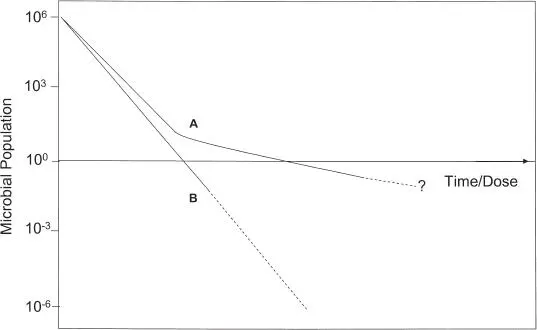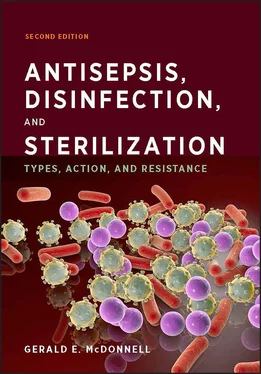Other specific methods are used to evaluate the efficacies of biocidal processes and products. These are generally used due to restrictions on the cultivation of various microorganisms under laboratory conditions. Microscopy or other detection (biochemical and genetic) methods for the presence of microbial contaminants have been used; however, these methods can identify the presence of an organism but may not necessarily detect its actual viability. A specific example of the use of microscopy is in the determination of the viability of protozoan (oo)cysts or helminth eggs. In the case of protozoa, the viability of cysts can be determined in vitro by suspension in a specific medium under controlled conditions (including temperature) to cause the cysts to excyst and release their vegetative forms (see section 1.3.3.4); this can be monitored microscopically and is considered a reasonable indication of cyst viability. Cell culture methods (using mammalian cells) have also been developed to determine cyst viability and are also widely used to culture viruses and some bacteria. In many of these cases, in vitro methods are not sufficiently developed to determine microbial viability, and the use of in vivo (animal) models is required. An example of this is the case of prions (see section 1.3.6), which are proposed to be infectious proteins; although the biochemical detection of the protein can be used as an initial indicator of inactivation and cell culture assays are currently under development, in vivo infectivity models are highly recommended to confirm activity against these unusual agents.
1.4.3 Disinfection versus Sterilization
In the consideration of biocides and biocidal processes, there is an important distinction between disinfection and sterilization. Disinfection is the reduction by an antimicrobial of the number of viable microorganisms to a level previously specified as appropriate for intended further handling or use; however, “safe to handle” does not necessarily mean that all microorganisms are killed or removed, and different levels of disinfection can be defined, including pasteurization, sanitization, and high-, intermediate-, or low-level disinfection (see chapters 2and 3). In contrast, sterilization is defined as a validated process used to render a surface or product free from viable organisms, or “sterile.” These include physical (e.g., heat and radiation [see chapter 5]) and chemical (e.g., ethylene oxide gas [see chapter 6]) processes. Disinfection efficacy can be demonstrated by using various surface and suspension tests (see section 1.4.2), many of which are specified to meet local requirements for product registration (e.g., in the United States with Food and Drug Administration- or Environmental Protection Agency-registered disinfectants). Sterilization processes require investigations that are more detailed. They include an analysis of the sterilizing agent itself and the definition of the use of the agent in a standardized sterilization process for specific applications.
Characterization of any sterilizing agent should include the following:
Definition of the sterilization agent (e.g., generation, stability, physical chemistry, and safety)
Detailed antimicrobial studies (see below)
Identification of the variables that can affect the antimicrobial activity of the agent, including temperature, humidity, time, distribution, penetration, and (for some applications) the presence of soil
The sterilization process should be shown to be effective against a broad range of microorganisms, including bacteria, mycobacteria, viruses, fungi, protozoa, and bacterial spores. From this analysis, specific resistant microorganisms (usually bacterial spores [see section 1.4.2.3]) are chosen to establish the mathematical relationship on exposure to the sterilizing agent. This can be determined by using the various suspension and surface tests (direct enumeration and fraction negative) specified in section 1.4.2and by plotting the number of microbial survivors on exposure to the sterilizing agent over time ( Fig. 1.25).

FIGURE 1.25 Rate of microbial inactivation on exposure to sterilization processes. In this case, the test microorganism (generally bacterial spores) at a starting population of 10 6is exposed to the sterilizing agent under two conditions (A and B). The number of microorganisms can be determined over contact time or dose using a combination of direct-enumeration and fraction-negative methods (solid lines). In process A, “tailing” is observed, which may not allow the extrapolation of the kill curve to a defined probability of survival (known as an SAL). In process B, the kill curve is linear, allowing extrapolation (dotted line) to an SAL of 10 −6.
This analysis allows the determination of the probability of a microorganism surviving the sterilization process, when the microbial reduction has been shown to be predictable (linear). Because it is difficult to confirm that sterility has been achieved with a given process, the concept of the sterility assurance level (SAL) is used. The SAL can be defined as the probability of survival of a viable microorganism after a sterilization process (generally expressed as 10 −n). For example, it is common in health care applications to use an SAL of 10 −6, implying a chance of less than one in a million that an item may be contaminated when a starting population of 10 6test organisms is present on the test surface.
When the sterilizing-agent conditions are understood experimentally, they can then be applied in actual sterilization processes, which include specific loads for treatment (like packaged liquids and devices) in equipment used to provide and control the required conditions (e.g., steam sterilizers or radiation exposure chambers [see chapters 5and 6]). These processes are also required to be tested to ensure that the minimum sterilizing conditions are met within the load. There are two basic methods recommended: overkill and bioburden-based methods. Overkill methods are probably the most widely used, in particular with sterilization of reusable medical devices. In these methods, a test microorganism (generally a resistant spore at a given population either directly in or on a product, or using a biological indicator) is placed at worst-case locations within the load, and the minimum time or dose to give a complete kill is determined; this time or dose is then at least doubled to give a conservative sterilization cycle. A typical overkill method is shown in Fig. 1.25B, giving an SAL of 10 −6. Bioburden-based methods are based on knowledge of the population size and resistance of microorganisms present on or in a product; similarly, the reduction of the bioburden over time or dose is determined and extrapolated to give the minimum conditions for the required SAL. In some cases, these methods can be combined in the validation of a specific sterilization process for a specific application.
1.4.4 Choosing a Process or Product
At least three factors should be considered in the choice of a biocidal process or product for a given application: antimicrobial efficacy, safety, and compatibility. For antimicrobial efficacy, the requirements and choice of biocide for a preservation application (generally bacteriostatic and fungistatic activity) vary from that of a sterilization process which should render a product sterile and free from microbial contamination. The spectrum of antimicrobial activities for various physical and chemical biocides are considered further in chapters 2to 6. The choice of biocidal treatment will often depend on the risk associated with the level and type of contamination on the surface or in a given product. An example is the Spaulding classification for reusable medical devices, which defines them as critical, semicritical, or noncritical based on the risk of infection with the presence of contamination. Critical devices demonstrate the greatest risk because they are introduced directly into the human body, with contact with the bloodstream or other normally sterile areas of the body; due to the risks associated with contamination, it is recommended that critical devices be sterilized. Semi critical devices present a lower risk, as they may contact intact mucous membranes or nonintact skin during use, and therefore a minimum requirement for high-level disinfection is recommended. High-level disinfectants are considered effective against all microbial pathogens, with the exception of large numbers of bacterial spores. Finally, noncritical devices present the lowest risk of transmission of infection, i.e., they contact intact skin only, and at a minimum should be reprocessed with intermediate- or low-level disinfectants. A similar risk assessment can be used in the choice of any antiseptic, disinfectant, or sterilization process for a given application.
Читать дальше













